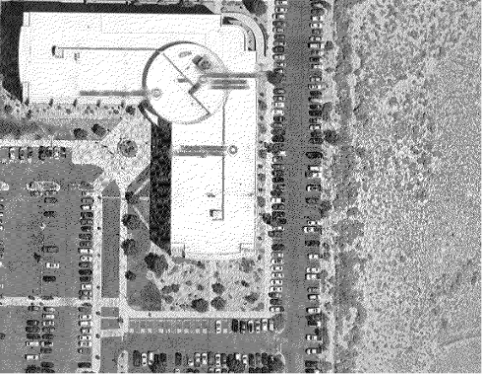Issue #63, Volume #2


How Government Defaults Destroy Real Wages… How To Protect Yourself
This is Porter’s Daily Journal, a free e-letter from Porter & Co. that provides unfiltered insights on markets, the economy, and life to help readers become better investors. It includes weekday editions and two weekend editions… and is free to all subscribers.
| The coming U.S. financial reset… The bond market is broken, says Jamie Dimon… The gold standard kept debt under control… First FDR defaulted, then Nixon… Poor people have been lied to and stolen from… Ships have stopped coming from China… |
Here’s some math that you might not like, but you’d better understand.
In only the last 20 years, per-capita federal debt has exploded by close to $100,000 per person – or about 300%. It’s likely to reach $150,000 per person by the end of President Donald Trump’s term in 2029.
There’s a growing likelihood (and I’d call it a certainty) that the entire U.S. financial system will have to be “reset,” because our government cannot afford these debts. If you doubt me, just ask yourself how many people you know that can afford their portion of the federal debt.
When JPMorgan Chase CEO Jamie Dimon talks about the bond market breaking (like he did last week), this is what he’s talking about: we can’t possibly afford these debts and, as a result, they are about to spiral out of control.
But don’t worry. This is normal. The U.S. government defaults about once every 50 years. And, this time, everyone knows it’s coming – because our debts have become so much larger than our entire economy.
In 1913, before America adopted the Federal Reserve system, the U.S. Treasury issued coins – gold and silver. Virtually all debts carried a gold clause, specifically calling for repayment in the precious metal. And banks had to keep large reserves (specie government bonds) to meet redemption demands.
This gold-backed system sharply limited the amount of money and credit, because, for the monetary system to grow, gold reserves had to grow too. Total credit was limited by these scarce reserves.
By the early 1900s, total credit in the U.S. economy (federal, state, local, and private debt) was around $50 billion. With a total GDP of around $35 billion, there was a total credit-to-GDP ratio of roughly 140%. As money and credit were physically connected to the real economy, wages grew with increases to productivity, meaning that a growing economy benefitted all Americans.
In 1913 (when America had real money), the average income was $800 per year. Under the Gold Standard Act of 1900, a U.S. dollar was legally equivalent to 1/20.67 troy ounces of gold. Said another way, an ounce of pure gold was worth $20.67. So today, to enjoy the equivalent income as the average American in 1913, you’d have to earn $128,000.
That was more than 100 years ago, so you’d expect that, in real terms, Americans would be making a lot more now. But, they’re not. Today’s average income is $62,000 – or about half what it was (in real terms) more than 100 years ago.
How’d that happen? A huge government default.
On April 5, 1933, President Franklin Roosevelt issued executive order #6102, which required U.S. citizens to surrender gold coins and gold certificates by May 1, 1933. Congress simultaneously passed a joint resolution nullifying gold-repayment clauses in contracts. And the next year, on January 31, 1934, President Roosevelt set the new price of gold at $35 per troy ounce, a 69% increase, thereby effectively devaluing the dollar and vastly lowering real wages.
This default also had the impact of greatly increasing the relative value of certain kinds of financial assets (like high-quality common stocks), collectibles (art and jewelry), and commercial real estate. And who owns this stuff…? Rich people.
All of this made rich people – especially rich people who were aware of the government’s plans – a lot richer. And poor people? Well, as usual, they got fucked.
Ironically, of course, FDR pitched all this as necessary because of the ongoing economic emergency. And who voted for FDR? Poor people. Reminds me very much of Trump’s promises that by arbitrarily raising taxes (he calls them tariffs) he will help “Main Street” at the expense of Wall Street. Don’t believe a word of it.
But hang on, that wasn’t the only government default. And the next one was even worse!
By 1971, the price of gold had risen a little – $42.22 per troy ounce – and the average American income had grown a lot, to $10,500. Thus, Americans were earning 248.7 troy ounces of gold per year, an income equal to $850,000 today!
Then President Richard Nixon defaulted.
The U.S. government’s budget deficits exploded in the 1960s, going from $3.3 billion in 1961 to over $25 billion in 1968. Total federal debt grew massively from $286 billion in 1960 to $400 billion by 1971… and then it continued to grow. Rather than cut the size of the government and balance the budget, Nixon continued spending. To do so, he was going to have to create a huge amount of new money and credit, far more than could be backed by gold. So he broke the dollar’s gold exchange rate permanently allowing the dollar (and thus the world’s financial system) to “float.”
How’s that worked out for the average American?
It’s been a disaster.
Today the average income in America is $62,000. But gold is now $3,200 per ounce. Thus, the average income is now only 20 troy ounces of gold.
That’s a 48% decrease from 1913 levels.
And a 91% decrease from prior to Nixon’s default.
How has so much wealth been destroyed?
Well, without a fundamental limit to money credit (gold reserves), our government began to borrow and spend at an unprecedented and completely unsustainable pace. Under the gold standard, debt levels in the U.S. peaked at around 150% of GDP.
Today, debts are vastly larger:
- Federal debt: $36 trillion
- State- and local-government debt: $4 trillion
- Household debt: $15 trillion
- Non-financial corporate debt: $15 trillion
- Financial-sector debt: $20 trillion
- Total debt: $100 trillion+ or more than 400% of GDP!
Now, think about what happens when you’ve got vastly more money and credit chasing scarce resources in an economy. Well, look, for example, at the cost of college. Or of nursing care. Or commodities that require massive capital investment to increase supplies.
Economists call this “inflation,” but an easier way to think of it is simply: this is what always happens when you print money.
What kind of an economy makes rich people so much richer, while making working people so much poorer? An economy that’s fundamentally unfair and fundamentally broken. Nothing Trump is doing is going to change any of this, either.
And, here’s the really bad news: all of this is going to get worse – a lot worse.
The scope of America’s debt and deficits is expanding rapidly and could enter an out-of-control feedback loop because of automatic cost-of-living-adjustments (“COLA”) to Social Security benefits and the rising cost of financing the government’s enormous debt load.
Let’s assume Trump’s tariffs end up increasing the price of imports around 20%, on average. That will mean large price increases for all kinds of products, as these costs will be passed on to consumers. If inflation increases modestly (to something like 5%), you’ll see Social Security and other kinds of mandatory transfer payments protected by automatic COLA increases of more $500 billion over the next four years. These higher costs, plus much higher interest expenses ($2.5 trillion per year), will lead to much higher-than-expected deficits. Total federal debt will reach $45 trillion by 2030. And, thus, by 2030, interest expenses will approach 40% of all government expenses!
That’s a doom loop for the U.S. dollar.
How will all of this get resolved…? I don’t know exactly, but it won’t be good for poor people. It never is. No matter what the government promises. The solution, undoubtedly, will entail a massive devaluation of the government’s obligations, either through repudiation, inflation, or both.
Thus, I’m very certain that people who are smart enough to hedge their portfolios with gold and Bitcoin and who own high-quality businesses will continue to see their relative wealth continue to increase.
Like writer/philosopher Ayn Rand explained: The poor have always been with us. Don’t be one of them.
What we had all better hope is that the average person never understands how they’ve been lied to and stolen from for the last 50 years. Because if people understood any of this, there might not be any safe place left in America.
On Wednesday, I’ll show you an ultra-simple way to protect yourself from the coming U.S. default.
Top Secret Facility In The New Mexico Desert…
Inside, scientists aren’t studying weapons or viruses – they’re exploring a far more alien technology that could change how wars are fought.
This new technology could be unleashed as soon as July 15.
Once you see it for yourself, you’ll understand the urgency.
Three Things To Know Before We Go…
1. Hedge funds boost bets on U.S. stocks. Gross leverage among U.S. hedge funds, which includes both long and short positions, has soared to a near all-time high (the 99th percentile). This is a reversal from April, when the tariff-driven volatility caused hedge funds to significantly pare back their market exposure. With the CBOE Volatility Index (VIX) plunging from a super-high 60 to under 20, fund managers now have the greenlight to ramp up leverage. And with most managers playing catch up to the market’s fast recovery, many are likely looking to leverage to make up for lost ground.
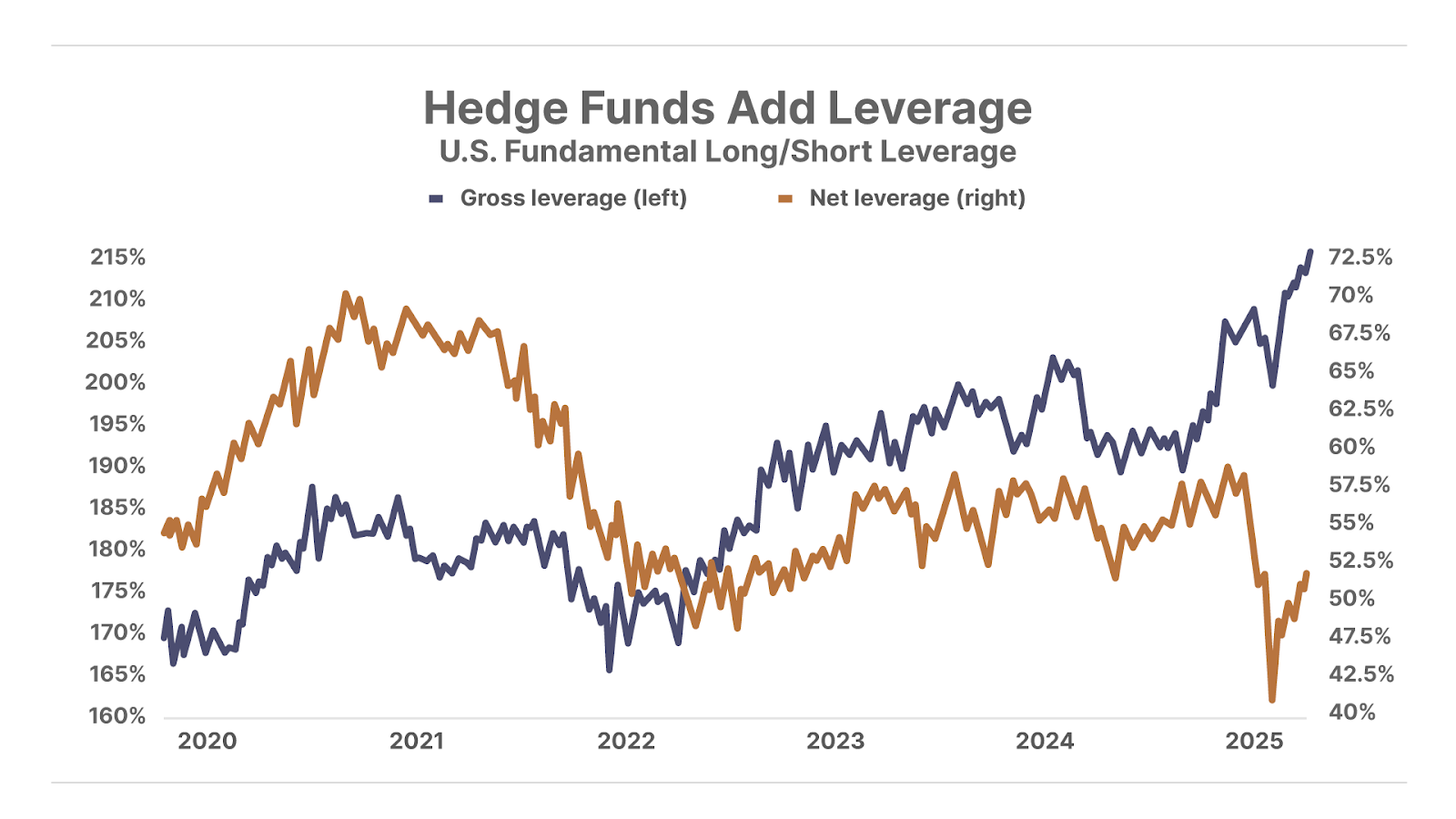
2. U.S.-China trade slows. China’s container-shipment volume to the U.S. has collapsed, despite President Donald Trump’s announcement on May 12 of a 90-day tariff pause. This reduced rates from 145% to 30%, still well above the prior 3% rate. Container shipments from China to the U.S. have fallen 50% since mid-April, reaching a one-year low (excluding the seasonal dip during February’s Chinese New Year). Following the President’s Truth Social post on Friday accusing China of violating its trade deal, China hit back today accusing the U.S. of “seriously violating” and undermining its agreements. Empty shelves and COVID-like shortages could soon be the reality if the trade war continues.
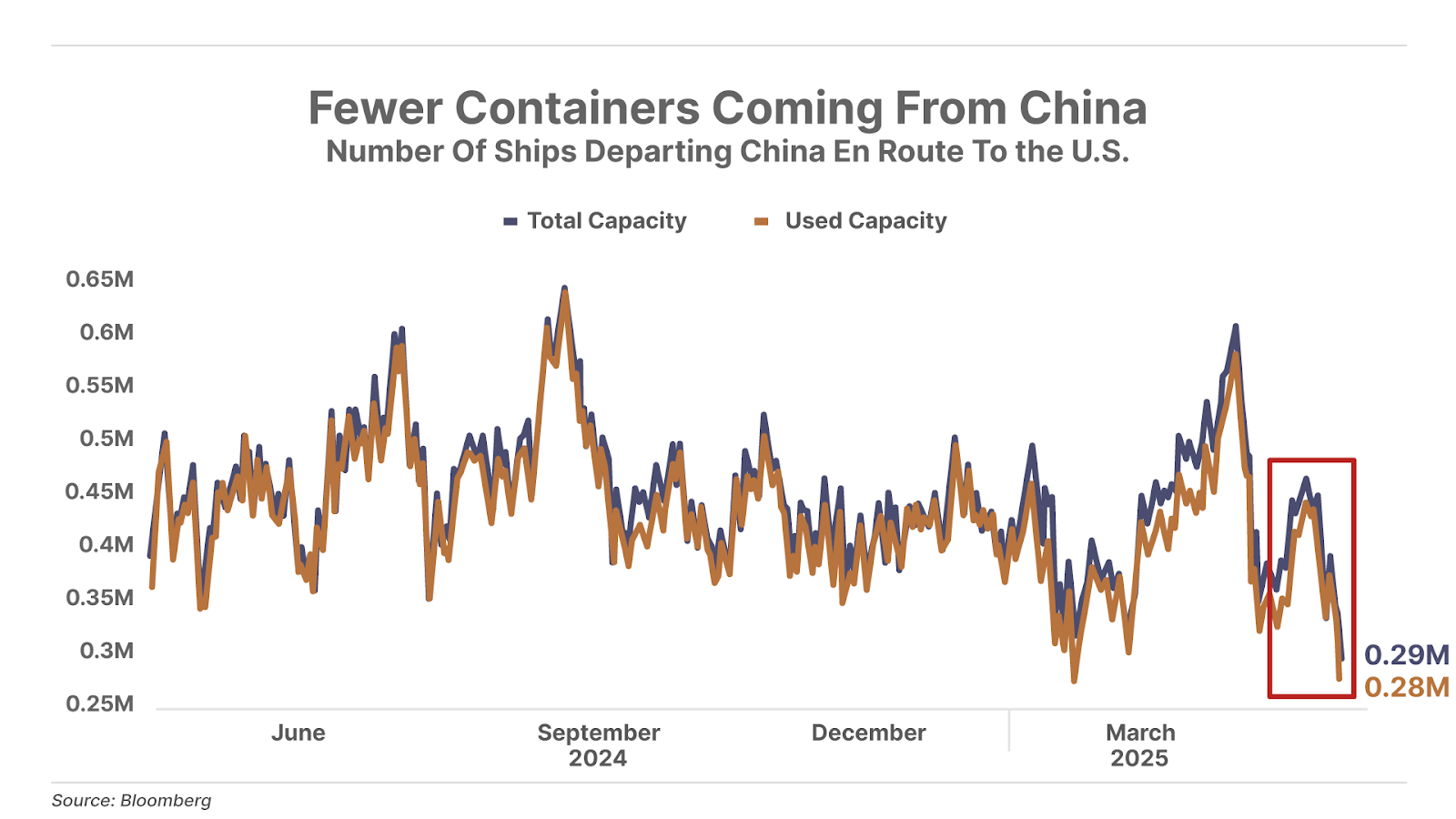
3. Global debt soars. Worldwide debt rose to a new high of $324 trillion in Q1, driven largely by an increase in government deficit spending. Total global debt is now nearly three times as large as the GDP of every nation in the world combined. Repeat after us: the spending will never stop.
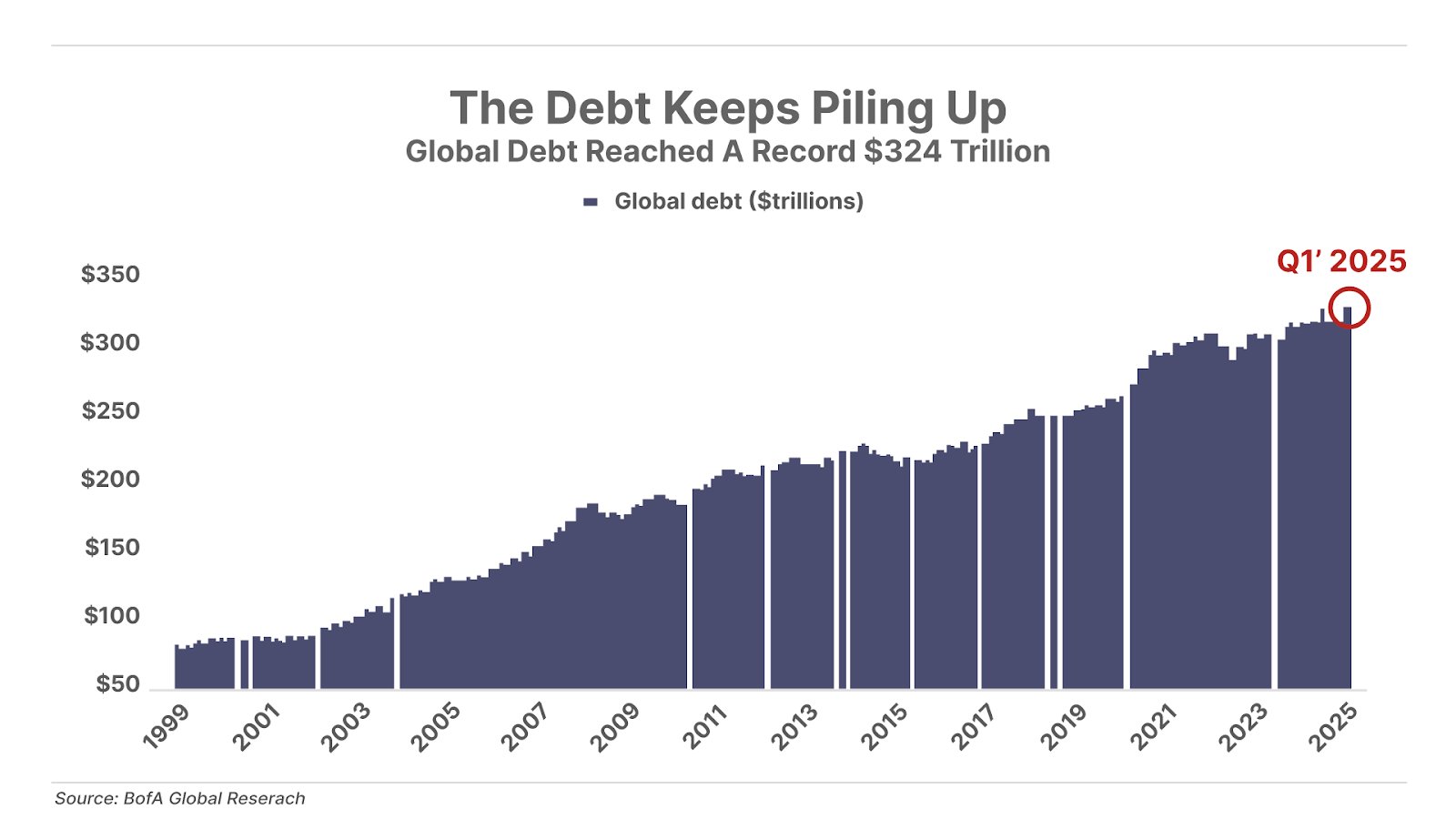
And One More Thing… Poll Results
On Friday, we asked readers: “Where will Bitcoin be at the end of 2025?” It seems we have bullish-on-Bitcoin survey takers: 43% selected that Bitcoin would be “more than 20% higher” than it is now – meaning above $125,000 – while 36% selected “10% to 20% higher,” and 22% are bearish, selecting “10% to 20% lower.”

Tell me what you think: [email protected]
Good investing,
Porter Stansberry
Stevenson, Maryland
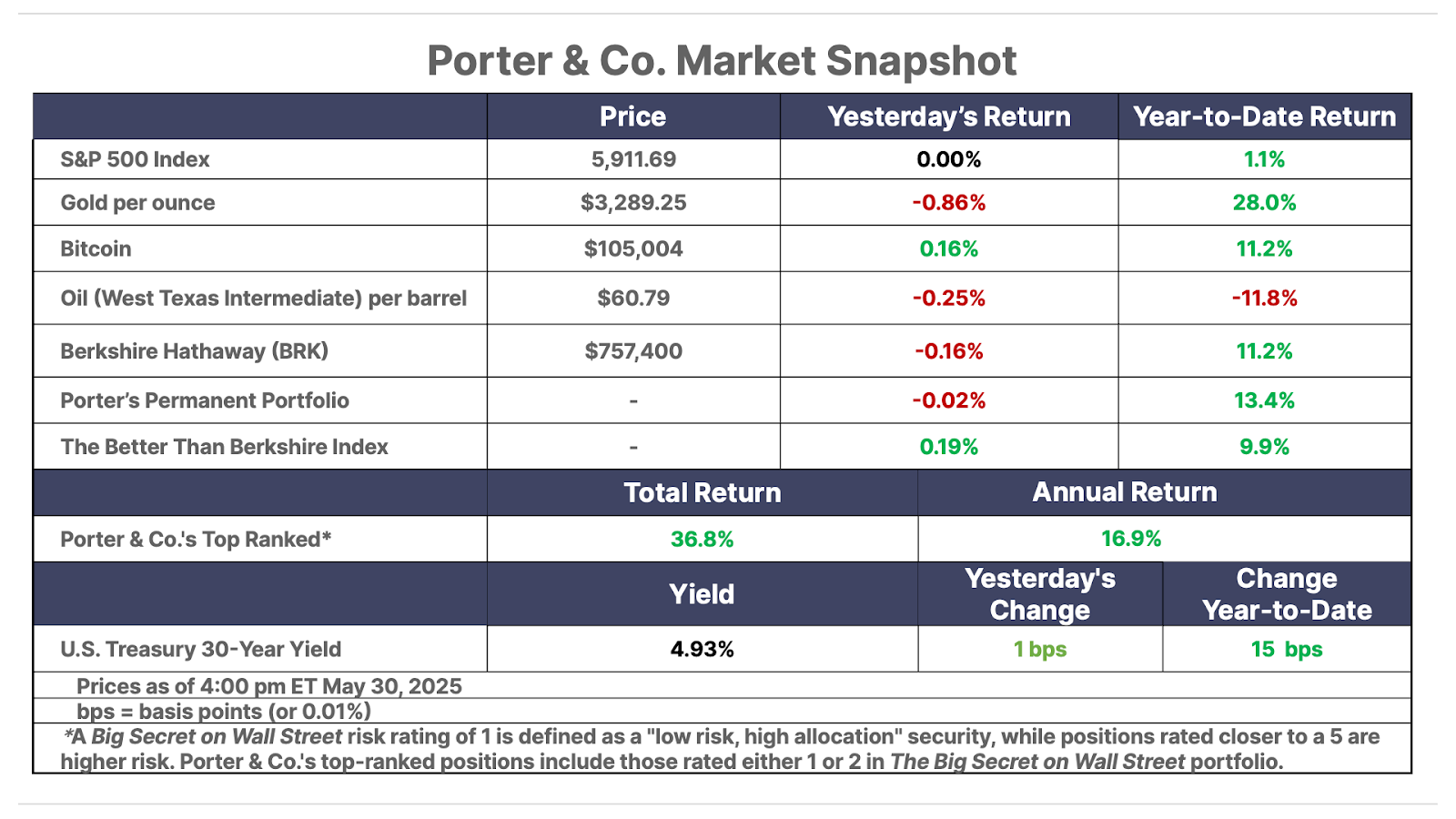
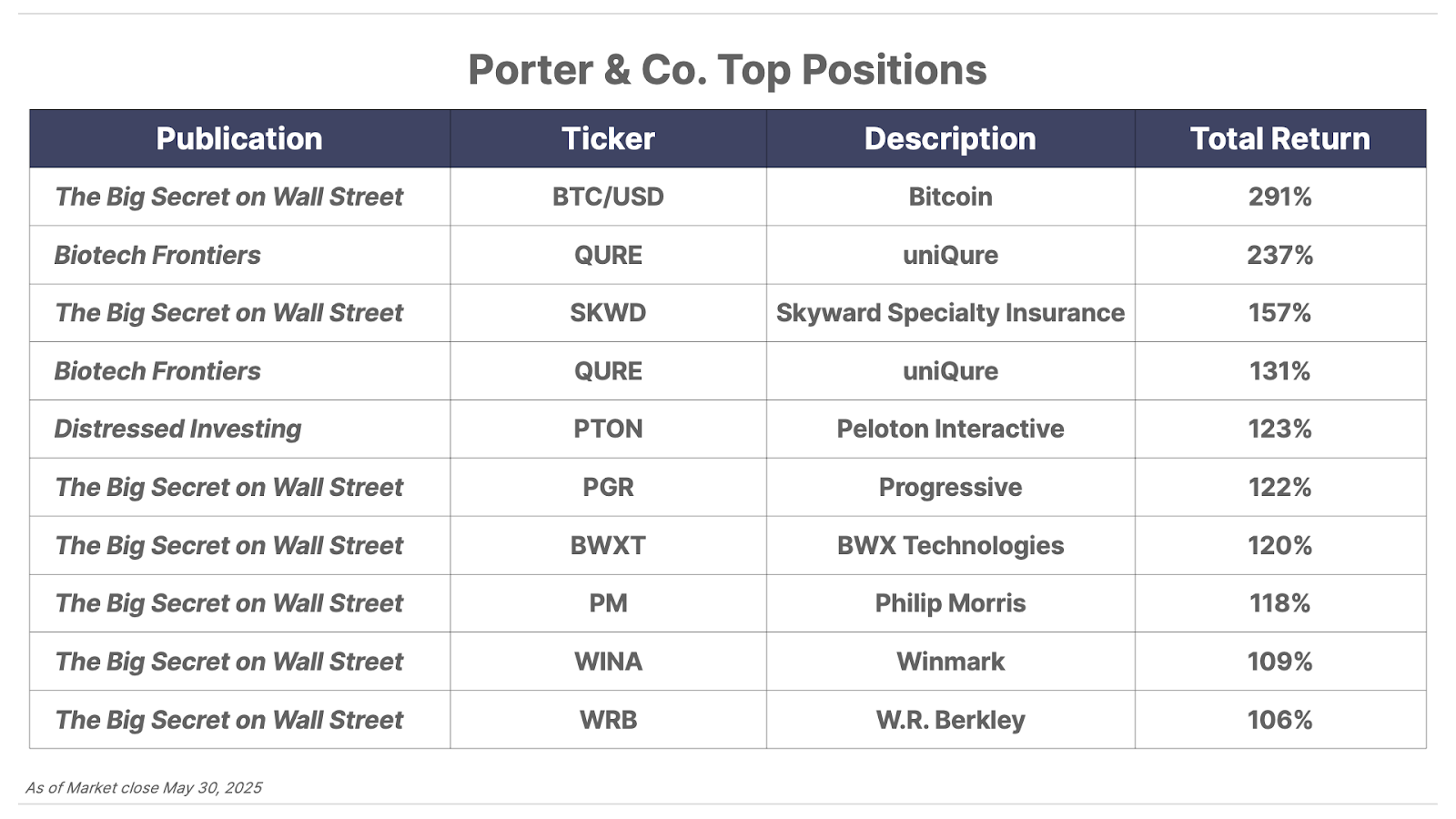
Please note: The investments in our “Porter & Co. Top Positions” should not be considered current recommendations. These positions are the best performers across our publications – and the securities listed may (or may not) be above the current buy-up-to price. To learn more, visit the current portfolio page of the relevant service, here. To gain access or to learn more about our current portfolios, call Lance James, our Director of Customer Care, at 888-610-8895 or internationally at +1 443-815-4447.
